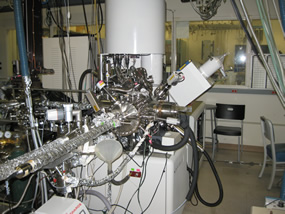Molecular Materials Resource Center
Nate Lewis – Principal Investigator
Azhar Carim — Manager
The goals of the MMRC are to synthesize, from the molecular level, materials and combinations of materials with unique and desirable properties and to provide the Caltech community with routine access to state-of-the-art instrumentation for materials characterization. Current emphasis of the Research Center is on materials and devices useful in artificial photosynthesis and solar energy conversion, electroactive compounds, unique nonlinear optical materials, devices capable of detecting volatile organic chemicals, formation of self-assembled monolayers on surfaces, surface science methods to probe the chemistry of solids, and characterization of magnetic materials ranging from asteroids to nanomaterials.

Instrumentation
- A UHV Kratos Ultra X-ray photoelectron spectrometer, with ultraviolet photoemission spectroscopy, low energy ion scattering spectroscopy, low energy electron diffraction, temperature programed desorption, and other related surface probes. This instrument also has a sample transfer case that can move a sample from an inert atmosphere into the instrument without exposure to the ambient atmosphere.
- An LKtech High Resolution Electron Energy Loss spectrometer.
- A UHV Surface Science M-Probe X-ray photoelectron spectrometer with and argon ion sputter.
- An Asylum Research MFP-3D-Bio Atomic Force Microscope mounted on an inverted optical microscope providing imaging of surfaces both in air and under liquids. Particularly suited to samples mounted on transparent substrates.
- A Bruker Dimension Icon Atomic Force Microscope with Nanoscope V controller with peak force tapping mode and ScanAsyst. This AFM is able to accommodate large samples.
- A Bruker MultiMode Atomic Force Microscopy.
- A Bruker STM with Nanoscope V controller. The STM can also be used for EC-STM.
- A Daktak XT stylus profilometer.
- A Quantum Design SQUID Magnetic Properties Measurement System Magnetometer.
- A Stark spectrometer to characterize charge-transfer transitions of molecules.
- A surface FTIR spectrometer.
- A Near-field Scanning Optical Microscope capable of also operating as a confocal microscope or AFM.
- An Ellipsometer capable of surface thickness measurements from Å to microns.
- A Cary 500 with integrating sphere to measure absorbance and transmittance of solids.
- A Floating Zone Optical Furnace for the synthesis of single crystals of metal oxides.
Areas of Expertise
Solid materials characterization using modern UHV-based surface science techniques; scanning probe microscope used to characterize specimens from biological samples to novel electronic materials; electrochemical characterization of charge-transfer properties and reduction potentials of molecular species, sensor array technology, heterogeneous and homogenous electron-transfer reactions, characterization of nano-particles and protein size using light scattering. Four laboratories in the subbasement of the BI are devoted to the development of nanomaterials for artificial photosynthesis, solar conversion studies, chemical sensor fabrication, inorganic synthesis, and sample preparation. Facilities include vacuum lines, Schlenk inert atmosphere lines, inert atmosphere boxes, a GC-MS instrument, spin coating, UV-vis spectrophotometer, and visible photolysis facilities.
Use of MMRC Facilities
Contact Azhar Carim or the appropriate member of the MMRC staff (see MMRC web pages). All users will be trained and required to demonstrate proficiency using the MMRC instrument before being allowed to work with the instrument on their own. The MMRC provides free access to its instrumentation and expertise although, in the case of extended use, a financial arrangement covering the cost of materials may be necessary.
People
Nate Lewis
Principal Investigator
- 210 – Noyes
- Mail Code 127-72
- (626) 395-6335
- nslewis@caltech.edu
Azhar Carim
Manager
- 318 – Beckman
- Mail Code 139-74
- Tel: (626) 395-2846
- aic@caltech.edu